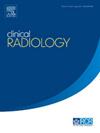布鲁氏菌感染动脉瘤的影像学特征:并发脊柱炎高发,无异位气体
IF 1.9
3区 医学
Q2 RADIOLOGY, NUCLEAR MEDICINE & MEDICAL IMAGING
引用次数: 0
摘要
布鲁氏菌病是一种未被充分认识的疾病。本研究旨在确定布鲁氏菌感染动脉瘤(BIA)的独特影像学特征。材料与方法2012年1月至2024年11月在某三级转诊医院进行回顾性队列研究,纳入26例BIA患者(经血清学检查和阳性血培养证实)和22例无布鲁氏菌的常见感染动脉瘤对照。诊断遵循既定的共识标准。分析临床、实验室和计算机断层血管造影(CTA)数据。两名放射科医生独立评估影像学特征。结果BIA患者平均白细胞计数较低[6.82±1.99标准差(SD)比13.62±12.74 (SD) × 109/L, P=0.010],阳性血培养较少(15.4%比68.2%,P=0.001)。CTA显示BIA患者无异位气体(0%对22.7%,P=0.004),但脊柱炎患病率较高(46.2%对18.2%,P=0.041)。其他特征,包括囊状形态、钙化(84.6%对77.3%)、动脉瘤周围发现和肾下位置(57.7%对72.7%),具有可比性。结合脊柱炎和无异位气体的诊断策略对BIA具有高特异性(86.26%)和阳性预测值(80.00%)。当排除结核病时,这种效果更加明显(特异性= 95.00%)。结论bia与其他感染动脉瘤具有相同的主要影像学特征(如囊状形态、瘤周炎症)。然而,没有异位气体和并发脊柱炎的高患病率是BIA的特点。这些发现支持早期布鲁氏菌特异性检测,以指导对疑似病例进行及时的抗菌治疗。本文章由计算机程序翻译,如有差异,请以英文原文为准。
Imaging features of Brucella-infected aneurysms: high prevalence of concurrent spondylitis and absence of ectopic gas
Aim
Arterial involvement in brucellosis is an underrecognized disease. This study aimed to identify the distinctive imaging features of Brucella-infected aneurysms (BIA).
Materials and methods
A retrospective cohort study was conducted at a tertiary referral hospital between January 2012 and November 2024, enrolling 26 patients with BIA (confirmed via serological examination and positive blood culture) and 22 common infected aneurysm controls without brucella. Diagnosis followed established consensus criteria. Clinical, laboratory, and computed tomography angiography (CTA) data were analyzed. Two radiologists independently assessed imaging features.
Results
Patients with BIA exhibited lower mean leukocyte counts [6.82 ± 1.99 standard deviation (SD) versus 13.62 ± 12.74 (SD) × 109/L, P=0.010] and fewer positive blood cultures (15.4% versus 68.2%, P=0.001). CTA revealed no ectopic gas in BIA (0% versus 22.7% in controls, P=0.004) but a higher spondylitis prevalence (46.2% versus 18.2%, P=0.041). Other features, including saccular morphology, calcification (84.6% versus 77.3%), perianeurysmal findings, and infrarenal location (57.7% versus 72.7%), were comparable. A diagnostic strategy combining spondylitis and absent ectopic gas demonstrated high specificity (86.26%) and positive predictive value (80.00%) for BIA. This effect was even more pronounced when tuberculosis was excluded (specificity = 95.00%).
Conclusion
BIA shares key imaging features (e.g., saccular shape, perianeurysmal inflammation) with other infected aneurysms. However, the absence of ectopic gas and the high prevalence of concurrent spondylitis are distinctive for BIA. These findings support early Brucella-specific testing to guide timely antimicrobial therapy in suspected cases.
求助全文
通过发布文献求助,成功后即可免费获取论文全文。
去求助
来源期刊

Clinical radiology
医学-核医学
CiteScore
4.70
自引率
3.80%
发文量
528
审稿时长
76 days
期刊介绍:
Clinical Radiology is published by Elsevier on behalf of The Royal College of Radiologists. Clinical Radiology is an International Journal bringing you original research, editorials and review articles on all aspects of diagnostic imaging, including:
• Computed tomography
• Magnetic resonance imaging
• Ultrasonography
• Digital radiology
• Interventional radiology
• Radiography
• Nuclear medicine
Papers on radiological protection, quality assurance, audit in radiology and matters relating to radiological training and education are also included. In addition, each issue contains correspondence, book reviews and notices of forthcoming events.
 求助内容:
求助内容: 应助结果提醒方式:
应助结果提醒方式:


